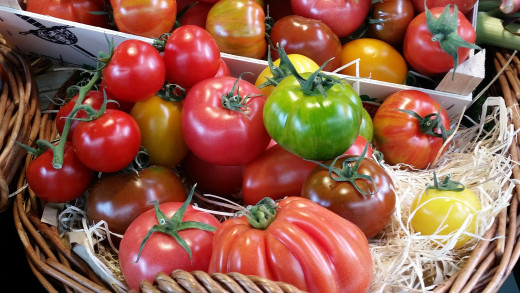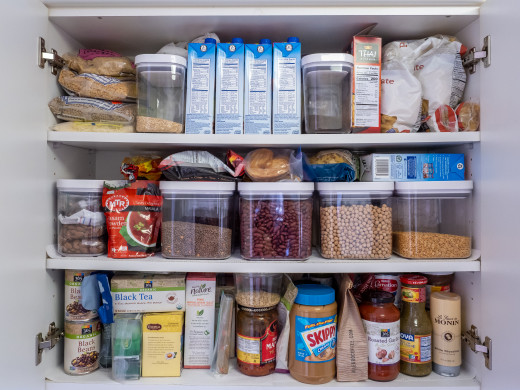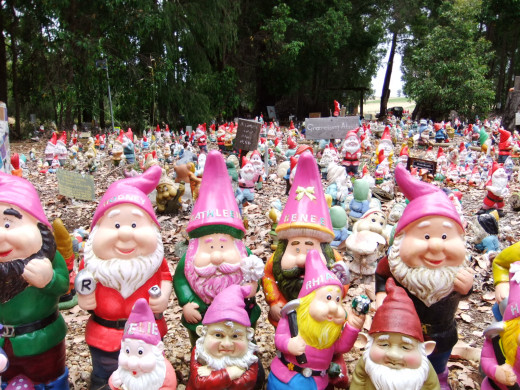How to Find Storage Space for Your Grocery Stash

One tried and true method of saving money on groceries is to stockpile.
What is Grocery Stockpiling?
Stockpiling simply refers to stocking up on sale items that your family often eats. Some families refer to their grocery stash as a year's supply, though few people have the room to stock up on that much food. Families may also have a store of garden foods that they have grown or preserved themselves.
Having more food than you need to get to the next payday helps in areas where winter weather can make traveling to the store a dicey ordeal. Having a grocery stash can also reduce eating out and those annoying trips to the grocery store to get that one item.

Stockpiling Gets a Bad Rap
During COVID, all those people shoving toilet paper into their carts gave stockpiling a bad rap. I don't recommend stockpiling at the expense of your neighbors. Lots of people grow food in a garden, preserving it for use during winter months. This is a sustainable practice. Buying a few extra cans at the grocery store is like putting money aside for a rainy day. I don't recommend you buy all of the toilet paper at the store!


A Grocery Stash Means Extra Savings and Peace of Mind
Stockpiling increases your savings on groceries by "extending the sale." It reduces time and travel to the grocery store.
If a family eats bottled spaghetti sauce once a week in your (almost) homemade spaghetti, then when you found the spaghetti sauce on sale, you would buy 5 or 6 extra bottles instead of the 4 bottles you need to get to the next payday.
Stockpiling, within reason, of course, can also help you to be more prepared for natural disasters (think snowstorms and hurricanes), and unnatural disasters, like a job loss.
Most of us don't have the luxury of a country kitchen with extra cabinets or a cool basement storage area. Here are some suggestions to make room for extra food.

Where to Put the Grocery Stash
Start in the pantry
If you have a pantry, start with a good cleanout. Reorganize everything, throw away redundant packaging, and use inexpensive organizing boxes from the dollar store, shoe boxes, or free boxes from the liquor store or big box store to bring order to shelves. Is it possible to add another shelf or two to your pantry? Can you add a storage organizer to the door? Create more space by adding narrow, wall-hugging shelf for canned items?

Where to store glass and canning jars
The resurgence of home canning has made many people realize a few things about all of those glass jars and bottles holding green beans, salsa, jam, and the like. A few glass jars can go just about anywhere. A whole collection of them need a heavy, preferably reinforced shelf. I keep mine on the lowest shelves of a pantry storage unit I repurposed from a book store that was remodeling. Store them low, in a cool, dark place if possible.
In the basement
If you are lucky enough have a basement, it can be an excellent place to store food, with constant temps below the 70s. Just be sure the basement area isn't damp. You may need to use a dehumidifier to keep the food in top shape.

Under the bed
If bending is not an issue for you, you could store your extra food under a bed. This isn't too much of a problem if the supply will be rotated into another area. Bed risers placed under the foot of a bed frame can raise the bed by 6 inches, allowing for ample storage space.
If you have a large supply of extra food, get everyone in the family in on the food storage. That's a lot of space for a lot of food. Consider placing canned goods stored in a drawer on caster wheels. These are very easy to make using an old dresser drawer. Or use a sturdy, old-fashioned suitcase to hold smaller canned items. Those canned items get heavy, and you want them easily accessible.
Repurpose a closet
Does your place include a coat closet? Coats could be moved to a space in the garage (either in boxes or a hanging wardrobe). Or you could move out your coats and possibly redistribute them to bedrooms, keeping canned goods in the closet instead.

In a tall dresser
Do you have a tall dresser you could squeeze in somewhere? I had a friend who had six kids. She doubled her storage by using old fancy dressers in unusual ways to decorate her home. She stored all kinds of stuff in them. If the canned goods were too heavy for you in a dresser, you could move the cans into your pantry and use the dresser for lighter items, like pasta, rice, and seasoning packets.
Remove the packaging
Have you taken things out of their packaging? It is shocking how much food you can compress into your actual pantry space by taking mixes out of their boxes and storing in plastic shoe-size containers, etc. I keep my most frequently used spices, cooking sprays, and a bottle of olive oil on a Lazy Susan on my counter-top next to my stove. I like spices, so I have more to store, but this frees up some space, too.
Hidden behind the door
Another idea is to take some bi-fold doors and turn them into a corner-closet hideaway for some of your food. You can get bi-fold doors at Habitat for Humanity resale shops for well below the usual cost. You could put this in a bedroom if an area is not available in the kitchen or nearby.


Hang up pots and reclaim storage cabinets
Do you have a laundry area? Could you squeeze an extra wire shelf in there? I would use a space like that to store any pots and pans that I used only occasionally and to store anything that wouldn't be bothered by the humidity caused by the washer and dryer. This might enable you to re-purpose some of the other cabinets in your kitchen for food storage.

Old television cabinet or freestanding wardrobe
Those cute TV cabinets from the 1980s and 1990s are everywhere. And they're heavy, and nobody wants to move them. And they make great places to increase pantry storage and can be hidden in plain sight. These are very easy and often inexpensive to find in online buy and sell sites. If you're lucky, you might find a beautiful conversation piece like the wardrobe in this picture. That would work too. but bring a brawny friend to move it!

Downsize other collections
If storing food is an important priority, is there something taking up space elsewhere that you no longer need? Maybe you could find ways to re-purpose other areas of closets or former video or craft storage?
To many of us, stockpiling food seems like a quaint and outrageous method of cost savings. But as the cost of food skyrockets, more and more people will be considering this method of grocery shopping. Good luck, and don't forget where you put it!
© 2008 Carolyn Augustine







![These Companies Will Send You Free Stickers [#05] These Companies Will Send You Free Stickers [#05]](https://images.saymedia-content.com/.image/t_share/MTczODA2NTA0NDkzOTgzMzcx/stickers-free.png)
